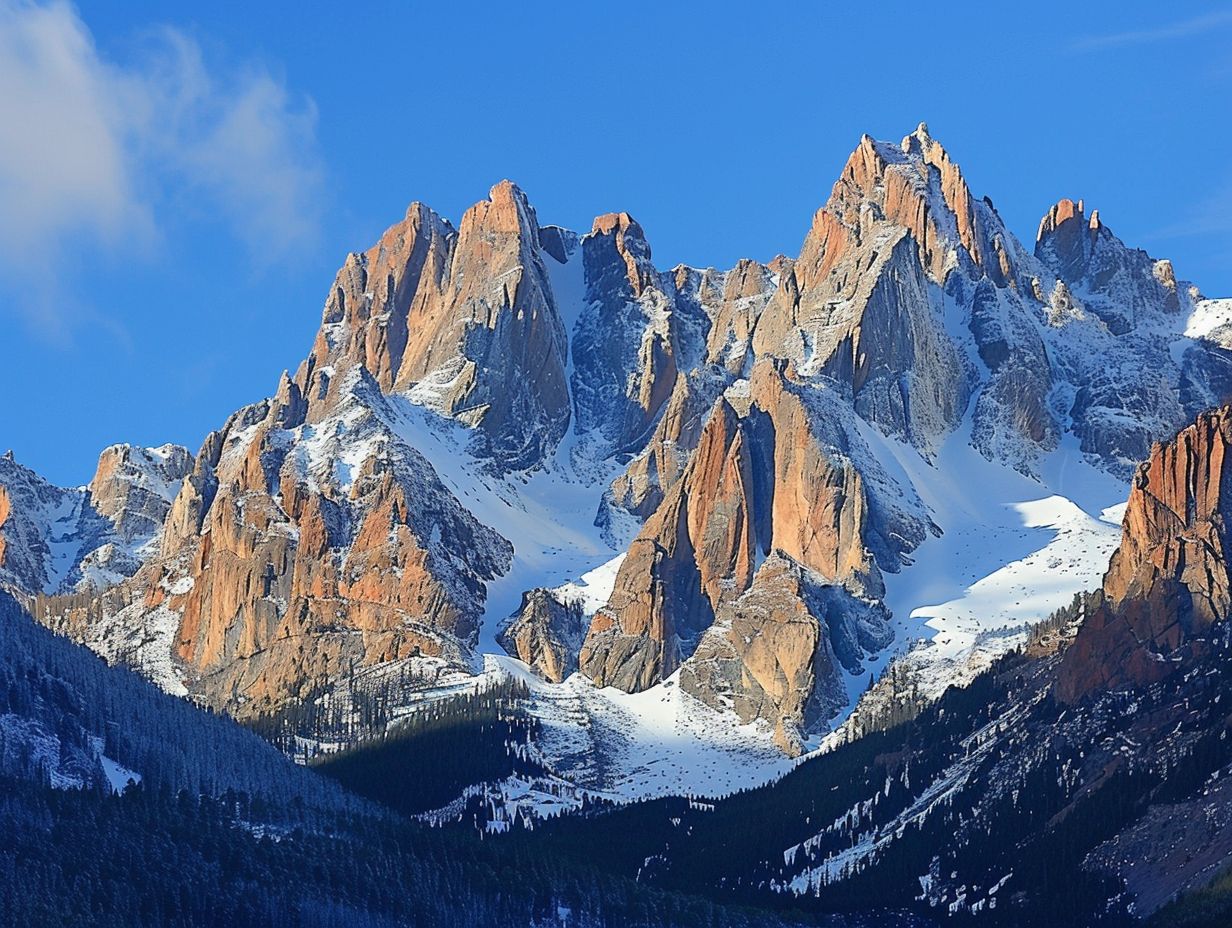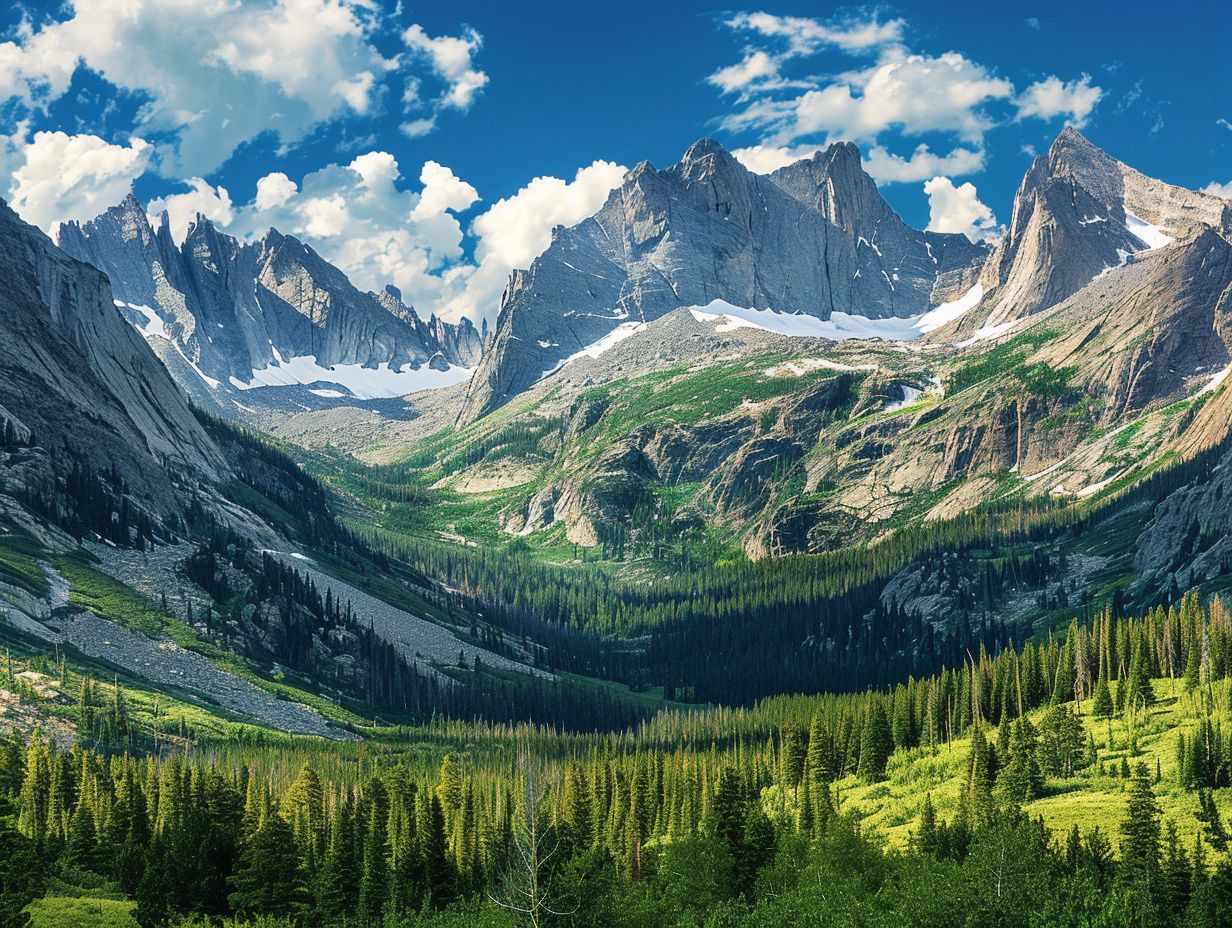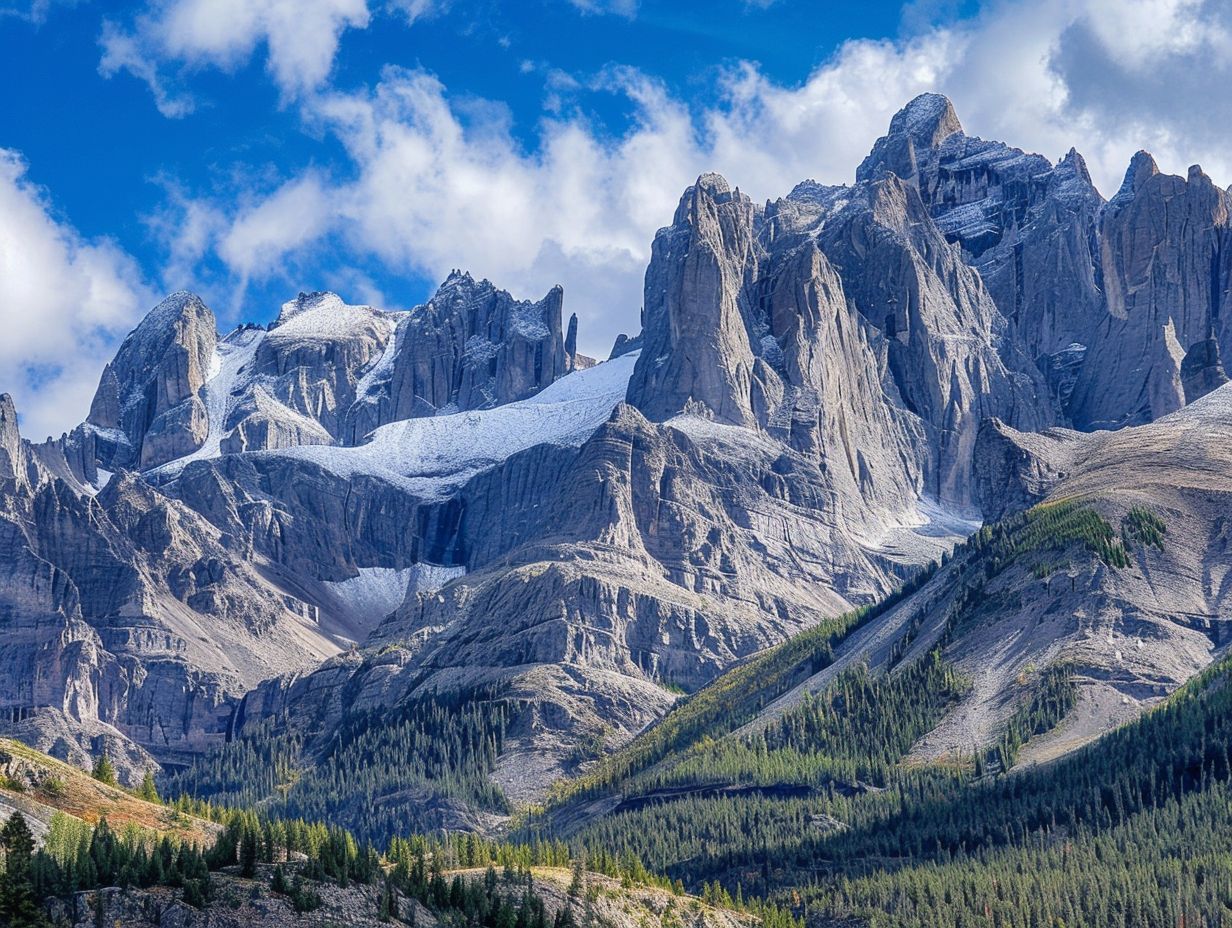
Tallest Mountains In North America
Have you ever wondered what makes a mountain a mountain?
We explore the tallest mountains in North America, including Denali, Mount Logan, and Pico de Orizaba.
From the majestic heights of Mount Saint Elias to the volcanic beauty of Popocatepetl, these mountains will take your breath away.
We also highlight other notable mountains in North America like Mount Rainier, Mount Whitney, and Mount Shasta. Get ready for a journey to the top!
Key Takeaways:

- The tallest mountain in North America is Denali (Mount McKinley) with a peak elevation of 20,310 feet above sea level.
- Mount Logan in Canada is the second tallest mountain in North America, standing at 19,551 feet high.
- Mount Rainier, Mount Whitney, and Mount Elbert are also notable mountains in North America, all exceeding 14,000 feet in elevation.
What Defines a Mountain?
Mountain ranges are geological formations that rise prominently from the surrounding terrain, often formed due to the collision of tectonic plates over millions of years. In North America, various mountain ranges showcase diverse geological histories, from the Sierra Nevada to the Appalachian Mountains.
These mountain ranges offer a glimpse into the dynamic geological processes that have shaped the continent over millennia.
The Sierra Nevada, for instance, boasts towering peaks like Mount Whitney, the highest summit in the contiguous United States. On the other hand, the Appalachian Mountains, one of the oldest mountain ranges on Earth, provide a rich tapestry of ancient rock formations and diverse ecosystems.
The gradual shifting of tectonic plates continues to influence the topography of North America, creating breathtaking landscapes that attract adventurers and geologists alike.
The Tallest Mountains in North America:
North America boasts some of the tallest and most majestic peaks, with Denali, Mount Logan, Pico de Orizaba, and Mount Saint Elias standing as prominent symbols of the continent’s geological grandeur. These mountains not only showcase towering heights but also provide a glimpse into the volcanic history of North America.
Denali, formerly known as Mount McKinley, is the highest peak in North America, reaching an impressive elevation of 20,310 feet above sea level. Its massive prominence and challenging weather conditions attract climbers from around the world.
Mount Logan, located in Canada’s Yukon Territory, stands as the second highest peak in North America. Its summit reaches a staggering height of 19,551 feet, making it a prime destination for experienced mountaineers seeking a formidable challenge.
Pico de Orizaba, or Citlaltépetl, is Mexico’s highest mountain and the third highest peak in North America, with an elevation of 18,491 feet. This volcano’s prominent stature and striking beauty make it a revered landmark in Mexican culture.
Mount Saint Elias, situated on the border between Alaska and the Yukon Territory, is known for its massive vertical relief and close proximity to the ocean. Rising 18,008 feet above sea level, this majestic peak offers stunning views and a unique geological composition.
1. Denali (Mount McKinley):
Denali, also known as Mount McKinley, is the highest peak in North America, located in the state of Alaska. Its towering summit is a testament to the geological forces at play, showcasing a mix of tectonic movements and glacial formations that have shaped its majestic presence.
Denali’s location in the heart of Alaska’s wilderness adds to its mystique, drawing adventurers and scientists alike to unravel its secrets. The mountain’s significance lies in its position within the Alaska Range, a region known for its rugged beauty and untamed wilderness.
The interplay of rock layers, uplifted by tectonic forces, and sculpted by glaciers over millennia, reveals a story of resilience and constant change.
2. Mount Logan:
Mount Logan, situated in Canada’s Yukon Territory, stands as the second-highest peak in North America. Its majestic height and glacier-clad peaks offer a breathtaking view that attracts climbers and nature enthusiasts from around the world.
Standing at an impressive height of 5,959 meters (19,551 feet), Mount Logan dominates the Saint Elias Mountains and the Kluane National Park and Reserve in southwestern Yukon.
Its peak is capped with ice and snow, a result of the numerous glaciers that flow down its slopes, shaping the rugged terrain. The mountain’s vast ice fields hold a significant amount of ice in the form of glaciers, contributing to the ideal setting for glacial studies and research.
3. Pico de Orizaba:
Pico de Orizaba, located in Mexico, is a prominent peak within the Sierra Madre Occidental and Sierra Madre Oriental mountain ranges. As part of the Trans-Mexican Volcanic Belt, this majestic volcano offers a spectacular sight, showcasing the geological diversity of the region.
Standing at an impressive 5,636 meters (18,491 feet) above sea level, Pico de Orizaba, also known as Citlaltépetl, is the third highest peak in North America.
Its snow-capped summit can be seen from miles away, dominating the surrounding landscape. The volcano’s volcanic eruptions and lava flows have contributed to the formation of nearby landforms and valleys, making it a significant geological landmark.
4. Mount Saint Elias:

Mount Saint Elias, part of the Saint Elias Mountains, is a majestic peak that straddles the border between Alaska, United States, and British Columbia, Canada. Its towering presence and glacier-clad slopes make it a captivating sight for adventurers and nature enthusiasts.
The peak rises to an impressive height of 18,008 feet, making it one of the highest mountains in North America. Nestled in the heart of the Wrangell-St. Elias National Park and Preserve, this colossal mountain offers a challenging yet rewarding climb for experienced mountaineers.
Its proximity to the Pacific Ocean influences the weather patterns, leading to rapid changes in conditions, adding an element of unpredictability to the ascent.
5. Popocatepetl:
Popocatepetl, a stratovolcano in Mexico, offers a unique blend of geological beauty and recreational opportunities. Its volcanic history and proximity to urban centers make it a popular destination for hiking and skiing enthusiasts seeking adventure amidst natural wonders.
Its towering presence, boasting an elevation of over 5,400 meters, dominates the skyline and beckons travelers to explore its rugged slopes. The volcano’s iconic snow-capped peak provides a stunning backdrop for outdoor activities, such as hiking along well-defined trails or skiing down its slopes during the winter months.
Popocatepetl’s volcanic nature adds an element of excitement and mystery, with occasional displays of steam and ash reminding visitors of its active status. Adventure seekers are drawn to the thrill of witnessing such raw power while immersing themselves in the breathtaking landscapes surrounding the volcano.
6. Mount Foraker:
Mount Foraker, located in Alaska, is a prominent peak known for its challenging climbs and stunning vistas.
With its towering presence in the Alaskan wilderness, Mount Foraker stands at about 17,400 feet high, featuring steep rock faces and icy ridges that test even the most experienced climbers. The mountain’s dramatic beauty draws adventurers from around the world, offering a mix of technical climbing routes and unpredictable weather conditions.
Mount Foraker’s location in the Alaska Range provides a breathtaking backdrop of snow-capped peaks and expansive glaciers, creating a paradise for those seeking a true alpine challenge.
7. Mount Lucania:
Mount Lucania, situated in Canada’s Yukon Territory, is a majestic peak that stands as one of the notable mountains in North America. Its towering presence and glacier-clad slopes offer a stunning backdrop for adventurers and nature enthusiasts exploring the region.
As the third-highest peak in Canada, Mount Lucania reaches an impressive height of 5,226 meters, beckoning climbers and mountaineers seeking a challenge. The mountain’s location near the Alaska border adds to its allure, providing a remote and rugged setting for those daring enough to attempt the ascent.
The intricate network of glaciers that drapes its slopes not only enhances the scenic beauty of the mountain but also plays a crucial role in shaping its landscape over millennia, sculpting valleys and ridges with their slow-moving ice masses.
8. Mount Blackburn:
Mount Blackburn, located in Alaska, is a striking peak that captivates with its rugged beauty and challenging terrain.
Rising to an impressive height of 16,390 feet, Mount Blackburn boasts a formidable presence among the Wrangell Mountains, standing as the fifth-highest peak in the United States. Its massive glaciers and steep slopes present a formidable challenge to even the most experienced climbers, with unpredictable weather adding an element of danger to any ascent.
The mountain’s remote location further adds to its mystique, requiring adventurers to embark on long and strenuous journeys to reach its base camp, enhancing the sense of accomplishment upon reaching the summit.
9. Mount Sanford:
Mount Sanford, situated in Alaska, is a prominent peak that beckons adventurers with its towering height and stunning vistas.
With an elevation of 16,237 feet, Mount Sanford showcases its rugged and majestic beauty amidst the vast Alaskan landscape. The mountain boasts a volcanic origin, adding to its mystique and allure for climbers seeking a challenging ascent.
Its snow-capped summit and glaciated slopes present a formidable yet awe-inspiring sight for those brave enough to tackle its formidable slopes. The journey to the top of Mount Sanford is not just a physical feat but a spiritual experience, with the vast wilderness surrounding you in all its untouched splendor.
10. Mount Fairweather:

Mount Fairweather, located on the border between Alaska and British Columbia, is a majestic peak that enthralls with its grandeur and natural beauty. As an iconic mountain in North America, Mount Fairweather offers a mesmerizing backdrop for adventurers and nature enthusiasts exploring the region.
Standing tall at around 15,300 feet (4,663 meters) high, this awe-inspiring mountain is known for its snow-capped summit that often seems to pierce the sky.
Its prominent location along the Fairweather Range grants breathtaking views of both the ocean and inland glaciers, making it a popular destination for those seeking the thrill of a challenging climb. The imposing presence of numerous glaciers, such as the Fairweather Glacier, subtly shapes the landscape around Mount Fairweather creating a stunning mosaic of ice and rock.
Other Notable Mountains in North America:
Apart from the tallest peaks, North America boasts a myriad of other notable mountains, such as Mount Rainier, Mount Whitney, Mount Elbert, Mount Robson, Mount Shasta, and Mount Hood. These mountains offer diverse opportunities for outdoor activities like hiking and skiing, attracting adventurers and nature enthusiasts alike.
Mount Rainier, located in Washington State, is renowned for its iconic snow-capped peak and challenging climbing routes.
Mount Whitney, the highest summit in the contiguous United States, attracts hikers seeking breathtaking views from its top.
Mount Elbert in Colorado stands as the highest summit of the Rocky Mountains, drawing climbers and backpackers to its rugged terrain.
Meanwhile, Mount Robson in Canada’s British Columbia is a picturesque peak within the Canadian Rockies, ideal for mountaineers and wilderness lovers.
Mount Shasta, a volcanic peak in California, offers a diverse terrain for hikers and skiers to explore.
Lastly, Mount Hood in Oregon allures outdoor enthusiasts with its year-round skiing and mountaineering opportunities.
-
Mount Rainier:
Mount Rainier, located in Washington state, is a majestic peak known for its iconic appearance and glacier-clad slopes. As a prominent mountain in North America, Mount Rainier offers a stunning backdrop for climbers, hikers, and nature enthusiasts exploring the Pacific Northwest.
Standing at an impressive 14,410 feet above sea level, this stratovolcano dominates the skyline with its snow-capped summit, visible from miles away. The thick glaciers that blanket Mount Rainier contribute to its picturesque beauty, captivating visitors with their shimmering ice formations.
The mountain’s diverse ecosystem, ranging from lush forests to alpine meadows, provides a habitat for a variety of plant and animal species, making it a paradise for wildlife enthusiasts.
-
Mount Whitney:
Mount Whitney, situated in California, is a prominent peak that beckons adventurers with its challenging trails and breathtaking vistas. As one of the notable mountains in North America, Mount Whitney offers a rewarding experience for hikers and outdoor enthusiasts seeking panoramic views of the Sierra Nevada region.
Standing at an impressive height of 14,505 feet, Mount Whitney is the tallest peak in the contiguous United States, attracting climbers from far and wide. Its location within the Inyo National Forest adds to its appeal, providing a serene backdrop for those embarking on the strenuous trek to the summit.
The mountain’s diverse terrain poses a significant challenge, with steep inclines and unpredictable weather conditions testing even the most experienced hikers. Despite the difficulties, the sense of achievement upon reaching the pinnacle makes the journey truly unforgettable.
-
Mount Elbert:
Mount Elbert, located in Colorado, is the highest peak in the Rocky Mountains and a popular destination for hikers and outdoor enthusiasts. Its towering summit and scenic trails offer a challenging yet rewarding experience for those exploring the natural beauty of North America.
Standing proudly at 14,440 feet, Mount Elbert beckons adventurers with its majestic presence in the Sawatch Range. The mountain’s peak boasts breathtaking panoramic views, showcasing the stunning landscapes of Colorado’s wilderness.
Hiking enthusiasts are drawn to its diverse terrain, ranging from lush forests to alpine meadows, providing an immersive journey through varied ecosystems. With its accessibility and well-maintained trails, many visitors are captivated by the opportunity to conquer this iconic mountain and revel in the sense of accomplishment that comes with summiting Mount Elbert.
-
Mount Robson:
Mount Robson, situated in British Columbia, Canada, is a majestic peak known for its stunning beauty and imposing presence. As a notable mountain in North America, Mount Robson offers a captivating sight for climbers, photographers, and nature enthusiasts exploring the Canadian Rockies.
The location of Mount Robson is key to its allure, as it stands within Mount Robson Provincial Park, a wilderness area celebrated for its diverse flora and fauna.
Rising to an impressive height of 3,954 meters (12,972 feet), its peak is often shrouded in swirling mists and dramatic weather patterns, adding to its mystique. The impact of glaciers on the landscape is evident, with massive ice fields feeding rivers that flow through lush valleys below, creating a dynamic and ever-changing terrain.
-
Mount Shasta:

Mount Shasta, located in California, is a prominent peak known for its spiritual significance and outdoor recreational opportunities. As one of the notable mountains in North America, Mount Shasta attracts hikers, climbers, and nature enthusiasts seeking adventure amidst its scenic beauty.
Nestled in the Cascade Range, this majestic mountain rises to an elevation of 14,179 feet, making it the second-highest peak in the range. The allure of Mount Shasta is not just its physical grandeur but also the spiritual aura that envelops it, believed by many to be a sacred site with mystical energy.
Hikers are drawn to its diverse trails, ranging from gentle slopes to challenging terrains, offering a variety of experiences for adventurers of all levels.
-
Mount Hood:
Mount Hood, situated in Oregon, is a prominent peak known for its iconic profile and diverse recreational opportunities. As a notable mountain in North America, Mount Hood offers a playground for skiers, snowboarders, and outdoor enthusiasts seeking winter adventures in the Cascade Range.
Located about 50 miles east-southeast of Portland, Mount Hood stands at an impressive 11,240 feet, making it the highest peak in Oregon. Its distinctive snowy cap and regular volcanic activity contribute to its allure. This active stratovolcano boasts several glaciers, the most prominent being the sprawling Eliot Glacier,
which covers about four square miles. These features, combined with its accessibility and well-maintained trails, attract thousands of visitors each year. Skiers flock to its slopes during the winter months, drawn by the challenging terrain and breathtaking views across the surrounding landscapes.
Frequently Asked Questions:
1. What are considered the tallest mountains in North America?
A: The tallest mountains in North America are Denali, Mount Logan, Pico de Orizaba, and Mount Saint Elias.
2. Where is Denali located?
A: Denali, also known as Mount McKinley, is located in the Alaska Range in the state of Alaska, USA.
3. How tall is Denali?
A: Denali is the tallest mountain in North America, standing at 20,310 feet (6,190 meters) above sea level.
4. What is the significance of Mount Logan?
A: Mount Logan is the second highest mountain in North America and the highest point in Canada, standing at 19,551 feet (5,959 meters) above sea level.
5. What country is Pico de Orizaba located in?
A: Pico de Orizaba, also known as Citlaltépetl, is a dormant volcano located in Mexico and is the third tallest mountain in North America at 18,491 feet (5,636 meters) above sea level.
6. How tall is Mount Saint Elias?
A: Mount Saint Elias, located on the border of Alaska and Yukon, is the fourth tallest mountain in North America at 18,008 feet (5,489 meters) above sea level.